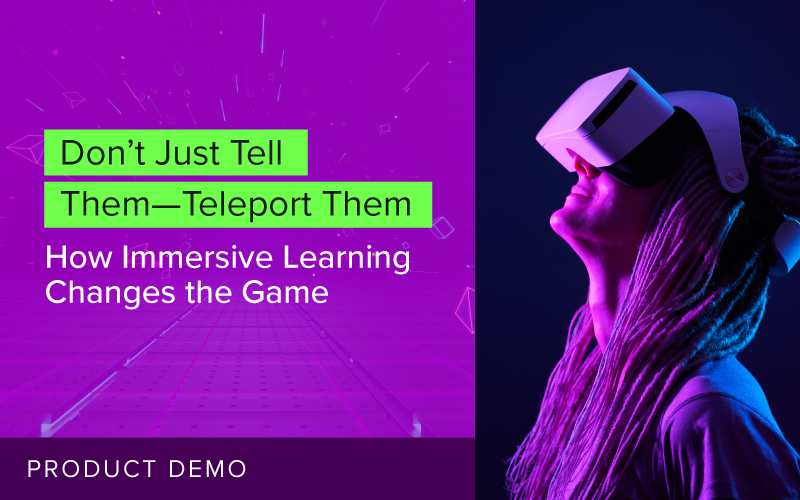Do you know how to swim? If so, did you learn by reading an instruction manual? Probably not.
A manual might be an okay way to conceptualize the arm movements, for example, but until you feel the water on your skin, adjust your balance, and learn to breathe in sync with your movement, you haven’t really learned to swim. This same principle applies to training in the workplace. You really have to get “in there” to know what you’re doing. But what if it’s dangerous in there? Or really expensive to get there? That’s where immersive learning can really save the day. It’s technology that helps you to know what it feels like in there.
In a recent webinar, ELB Learning’s own Sheryl Coggins showcased CenarioVR®, our immersive learning authoring tool. She demonstrated how CenarioVR® makes it possible to create high-impact training without a line of code. Whether it’s teaching warehouse safety protocols or assembling the perfect deli sandwich in a restaurant, CenarioVR® enables learners to feel like they’re there.
Why Immersive Learning Matters
Immersive learning gives people the chance to engage in scenarios that feel real—whether on a desktop, mobile device, or virtual reality (VR) headset. This pseudo-reality helps learners absorb knowledge through experience, not just information.
“The only source of knowledge is experience.” — Albert Einstein
It’s not just about flashy tech. Immersive learning reinforces behavior change by asking learners to participate, make decisions, and see the consequences—before they encounter those same challenges on the job.
Easy Entry: No Coding Required
Many virtual reality tools are designed for developers. CenarioVR®, on the other hand, is made for learning professionals. If you can storyboard a course, you can build it in CenarioVR®. With drag-and-drop functionality, an intuitive interface, and built-in logic controls, anyone can start building interactive content from day one—no development team required.
Plan Your Experience
Like anything else, it all starts with a solid plan. Storyboarding helps define what learners need to do and see, ensuring that visuals and interactions are intentional. Whether you use hand-drawn sketches or AI-generated mockups, visualizing your design up front makes development smoother.
If you need some direction on getting started, check out our VRoom ebook. It walks you through key questions like: Is VR the right modality? Should this content live in a game, a traditional module, or an immersive scenario? The ebook even covers how to gain stakeholder buy-in and evaluate your return on investment.
Realism Drives Retention
CenarioVR® encourages creators to use real-world environments—like a photo of an actual warehouse or office—because authenticity leads to better engagement. Learners can identify hazards, practice procedures, or respond to challenges in spaces they recognize. In a forklift hazard scenario, learners had to clean a water spill or mark it with a cone, with each option scoring different points based on effectiveness. Elements like drag-and-drop functionality, visibility toggles, motion paths, and branching logic are built-in and easy to configure.
Test and Iterate On the Fly
CenarioVR® makes testing effortless, too. Each project comes with a built-in QR code that allows instant mobile testing. You can preview, tweak, and re-publish in real time, which is ideal for agile development and cross-device compatibility. The tool also supports SCORM, xAPI, and HTML5 publishing formats, so your immersive training can live inside your LMS, on your servers, or run offline. It also integrates seamlessly with Lectora!
Proof That It Works (a Few Case Studies)
- Wincanton and Video Interact used CenarioVR® to reduce workplace incidents in three key areas—and saw a 300% ROI. They filmed their training in their own facility using real staff to give the experience absolute authenticity.
- Fendi used the platform to simulate shoplifting prevention, resulting in a 400% ROI improvement within six months.
- CatapalloVR created 170 modules in just 14 months, using CenarioVR® as their primary development tool—maximizing efficiency while delivering measurable value.
Explore the Extras
CenarioVR® offers more than just a blank canvas. You can use the AI Wizard to generate custom 360° environments. Tap into the Asset Library for prebuilt objects and backdrops. Add motion paths, 3D objects, timers, scoring, and video to build complex, engaging interactions. It even supports fixed objects that follow the learner’s field of view, which is a great way to create persistent tool panels or interactive sidebars in a 360° space.
If you need object order validation for step-by-step tasks like sandwich building or process assembly, you can define the sequence learners must follow.
And if you ever want to show off your work, you can publish your project as a SCORM package or run it natively within a Lectora course. The flexibility is incredible.
Final Takeaway
You don’t need a programming degree or an expensive dev team to create truly engaging, immersive learning. You just need the right mindset, a clear plan, and a tool like CenarioVR® to bring your training to life.
Ready to explore immersive learning? Watch the full webinar on-demand below.
If you’re ready to dip your toe into the waters of immersive learning, try CenarioVR®.
_______________
Disclaimer: The ideas, perspectives, and strategies shared in this article reflect the expertise of our featured speaker, Sheryl Coggins. Be sure to follow her on LinkedIn to explore more of her insights.







